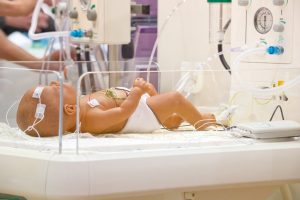
Breastfeeding has many benefits for both mother and baby, but one major drawback: it is incredibly difficult to know how much milk the baby is actually drinking. To end the guesswork of breastfeeding, an interdisciplinary team of engineers, neonatologists, and pediatricians at Northwestern University has developed a new wearable device that continuously monitors milk consumption with clinical accuracy. The unobtrusive device is gently and comfortably placed around the breastfeeding mother’s breast during feeding and transmits the data wirelessly to a smartphone or tablet.
The mother can then see in real time on a graphical display how much milk her baby has drunk. By eliminating uncertainty, the device can reassure parents in the first days and weeks after the birth of their child. In particular, the new technology could help reduce parental anxiety and improve clinical nutrition for vulnerable infants in the neonatal intensive care unit (NICU). The study was published in the journal Nature Biomedical Engineering.
Mothers are Very Uncertain Whether Their Babies are Getting Enough Milk
To ensure its accuracy and practicality, the device underwent several rigorous testing phases, including theoretical modeling, laboratory experiments, and tests on a group of young mothers in the hospital. “Knowing exactly how much milk an infant is getting during breastfeeding has long been a challenge for parents and healthcare professionals,” said John A. Rogers of Northwestern University, who led the development of the device. “This technology eliminates that uncertainty and provides a convenient and reliable way to monitor milk intake in real time, whether in the hospital or at home.”

“Uncertainty about whether an infant is getting enough nutrition can be stressful for families, especially breastfeeding mothers with premature babies in the neonatal intensive care unit,” said Dr. Daniel Robinson, a neonatologist at Northwestern Medicine and co-author of the study. “Currently, there are only cumbersome methods to measure how much milk a baby has consumed during breastfeeding, such as weighing the baby before and after breastfeeding. We expect this sensor to be a major advance in breastfeeding support, reducing stress for families and increasing confidence for clinicians as infants progress with breastfeeding but still require supplemental feeding. Reducing uncertainty and supporting families in achieving their breastfeeding goals will lead to healthier children, healthier mothers, and healthier communities.”
Previous Methods of Determining Milk Intake Not Very Effective
The project began four years ago when neonatologists and pediatricians at Lurie Children’s Hospital approached Rogers’ team with an urgent problem. Because milk transfer from mother to baby is not visible during breastfeeding and milk flow varies, it is nearly impossible to determine the exact amount of milk a baby consumes per feeding. Some pediatricians and lactation consultants weigh the baby before and after breastfeeding to estimate the amount of milk consumed. Unfortunately, baby scales are not small and most people do not own one. This provides an approximate value, but is not very practical.
Another option is for mothers to pump breast milk into a bottle. Bottle feeding allows for accurate measurement of milk volume and visual confirmation that the baby is drinking milk, but skin-to-skin contact is lost. In addition, pumping, storing, and handling milk is time-consuming and can even increase the risk of bacterial contamination. According to the researchers, there are no clinically validated technologies that meet this important medical need, so they have been working to fill this gap.
Finding the Right Strategy
Rogers’ team had previously developed soft, flexible wireless body sensors for monitoring babies in the neonatal intensive care unit, as well as wearable sensors for tracking fluid drainage through shunts, which are commonly used to treat patients with hydrocephalus. With their experience working with vulnerable populations and developing devices to measure fluid flow, Rogers and his team were the ideal candidates for the project.
After years of unsuccessful attempts using methods to monitor the optical properties of the chest, quantify sucking movements, track swallowing, and several other methods, the engineers finally settled on a remarkably simple technique. The device sends a tiny, safe electrical current through the breast using two small pads or electrodes placed on the skin. Another pair of electrodes detects the voltage difference associated with this current.
When the baby drinks milk, the amount of milk in the breast decreases. This reduction causes a subtle but measurable change in the electrical properties of the breast. These changes are directly related to the amount of milk removed from the breast. The greater the amount, the greater the change in electrical properties. Although this change is subtle, it can be accurately calibrated and quantified to display it in real time on a smartphone during breastfeeding.
“This concept is called bioimpedance and is commonly used to measure body fat percentage,” Rogers said. “Since muscles, fat, bones, and tissue conduct electricity differently, bioimpedance can be used to accurately measure fat content. In a similar way, we can quantify the change in milk volume in the breast. Unfortunately, this was the last strategy we tried. Fortunately, however, we found that it works very well.”
Detailed Computer Models of the Breast
After developing initial prototypes, the engineering team optimized them in several testing and modeling phases. First, they built simplified models of a breast using materials that mimic the electrical properties of skin, fat, and milk. By precisely controlling the “milk volume” in these models, the researchers could see how the device’s data changed as the “milk volume” changed.
Led by Avila at Rice University, the team then created detailed computer models of the breast based on actual anatomy. Their physical computer simulations monitored the physiological changes that occur during breastfeeding. Using bioimpedance, Avila linked the flow of electrical signals in real time to the amount of milk exiting the breast. His team’s anatomically accurate computer models take into account patient-specific breast shapes and tissue distributions, allowing them to test how sensor placement and tissue variations affect measurements.
Customizable for All Shapes and Sizes
The result is a thin, soft, and flexible cable that easily wraps around the outer circumference of the breast. Electrodes are integrated at both ends of the cable and adhere gently to the skin. A small, lightweight “base station” that also rests gently on the skin is located in the middle of the cable between the electrodes. The base station is housed in a soft silicone case and contains a small rechargeable battery, Bluetooth technology for wireless data transmission, and a memory chip.
Since every mother has different breast density, shape, and size, the device can be individually adjusted through a one-time calibration. To calibrate the system, the mother wears the device while using a breast pump connected to a bottle with volume markings. This allows the user to determine the exact amount of milk pumped over a specific period of time. Meanwhile, the device records the electrical properties of the breast throughout the pumping process. This calibration scheme teaches the device to interpret the changes in electrical signals for each individual mother.
After developing prototypes, the team tested the device on 12 breastfeeding mothers, both in the neonatal intensive care unit and at home. To assess whether the device works consistently and reliably over a longer period of time, the researchers took several measurements from the same mothers over a period of up to 17 weeks. In this initial test phase, the mothers wore the sensor while pumping, as the exact amount of milk pumped had to be known for this important step. In a test session, the researchers compared the device data with the difference in the baby’s weight before and after breastfeeding. Overall, the results were remarkably similar between the amounts in the bottle and the amounts recorded by the sensor during pumping.
Improving Care in the Neonatal Intensive Care Unit
While the device would provide reassurance and useful information to all parents, the researchers say that newborns in the neonatal intensive care unit would benefit most from careful monitoring. Knowing exactly how much a baby is eating in the neonatal intensive care unit is even more important than for healthy, full-term infants. These babies often have very specific nutritional needs. Premature babies, for example, may have an underdeveloped digestive system, making them more susceptible to food intolerances. Precise dosing of food can help minimize the risk of intestinal disorders and reflux.
Device to be Further Optimized to Provide Even More Information
To further improve user-friendliness, the researchers envision that the technology could eventually be integrated into comfortable undergarments such as nursing bras. This would further improve the device’s usability and the overall experience for mothers. The researchers plan to continue conducting comprehensive comparisons with weighing before and after breastfeeding. The team also wants to ensure that the sensor can be used by mothers with different skin tones. While the current version of the device measures the amount of milk flowing from the breast, future versions could also measure the milk flowing back into the breast.
This would allow mothers to track changes in milk production over time. The team also plans to further optimize the device so that it can provide even more information, such as milk quality and fat content. According to the researchers, eliminating uncertainty and reassuring mothers that they are producing enough milk helps reduce stress and anxiety. For all mothers around the world who are at different stages of breastfeeding, this device can be an incredible help.



